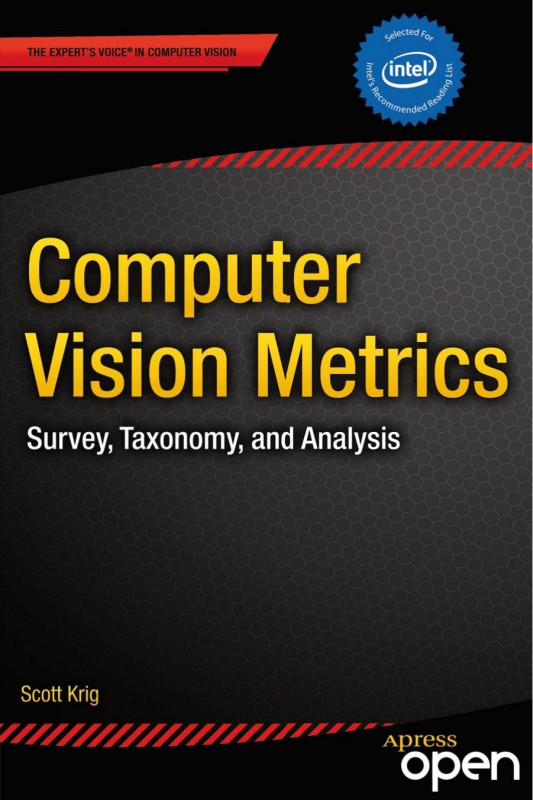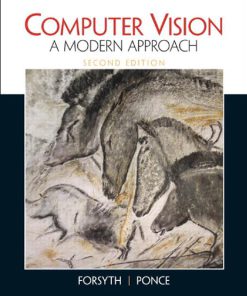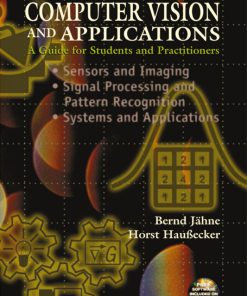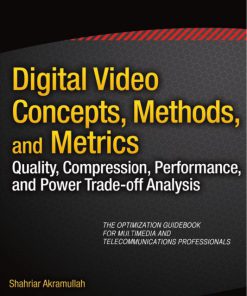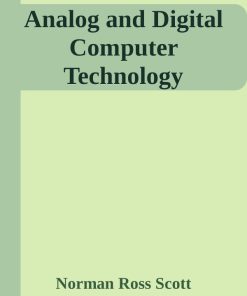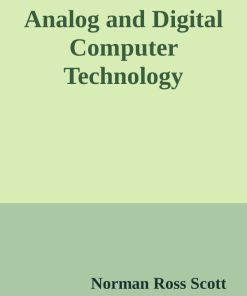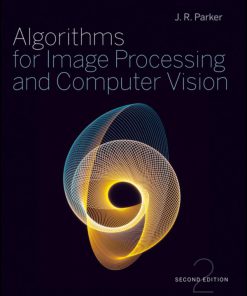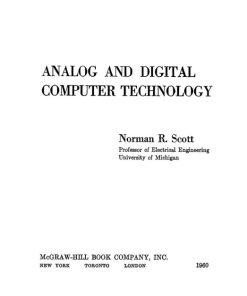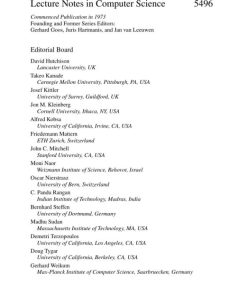Computer Vision Metrics Survey taxonomy and Analysis 1st edition by Scott Krig ISBN 1430259299 978-1430259299
$50.00 Original price was: $50.00.$25.00Current price is: $25.00.
Authors:Scott Kring , Series:Computer Science [184] , Author sort:Kring, Scott , Languages:Languages:eng , Published:Published:May 2014 , Publisher:Apress
Computer Vision Metrics Survey,taxonomy,and Analysis 1st edition by Scott Krig – Ebook PDF Instant Download/Delivery. 1430259299 978-1430259299
Full download Computer Vision Metrics Survey,taxonomy,and Analysis 1st edition after payment
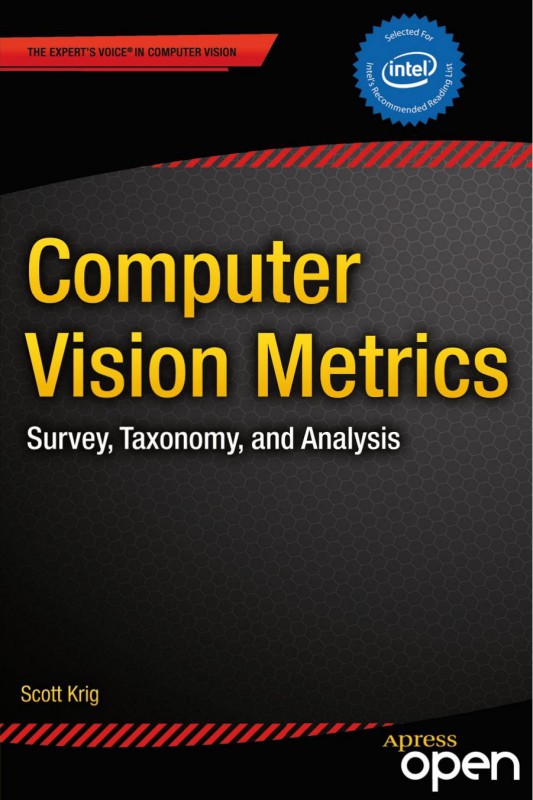
Product details:
ISBN 10: 1430259299
ISBN 13: 978-1430259299
Author: Scott Krig
Computer Vision Metrics provides an extensive survey and analysis of over 100 current and historical feature description and machine vision methods, with a detailed taxonomy for local, regional and global features. This book provides necessary background to develop intuition about why interest point detectors and feature descriptors actually work, how they are designed, with observations about tuning the methods for achieving robustness and invariance targets for specific applications. The survey is broader than it is deep, with over 540 references provided to dig deeper. The taxonomy includes search methods, spectra components, descriptor representation, shape, distance functions, accuracy, efficiency, robustness and invariance attributes, and more. Rather than providing ‘how-to’ source code examples and shortcuts, this book provides a counterpoint discussion to the many fine opencv community source code resources available for hands-on practitioners.
Computer Vision Metrics Survey,taxonomy,and Analysis 1st Table of contents:
Preface
- Introduction to the Book
- Scope and Objectives of the Survey
- Target Audience
- How to Use This Book
Part 1: Introduction to Computer Vision Metrics
Chapter 1: Introduction to Computer Vision
- What is Computer Vision?
- Common Computer Vision Tasks (Image Classification, Object Detection, Segmentation, etc.)
- Importance of Performance Metrics in Computer Vision
- Challenges in Evaluating Computer Vision Models
Chapter 2: Overview of Computer Vision Metrics
- Definition and Types of Metrics
- Evaluation and Comparison of Algorithms
- Metrics in the Context of Machine Learning and Deep Learning
- Common Evaluation Benchmarks and Datasets in Computer Vision
Part 2: Taxonomy of Computer Vision Metrics
Chapter 3: Metrics for Image Classification
- Accuracy, Precision, Recall, and F1 Score
- Confusion Matrix and Its Interpretation
- Area Under the Curve (AUC) and ROC Curves
- Top-k Accuracy and Other Evaluation Measures
- Dataset-Specific Metrics (e.g., ImageNet, CIFAR-10)
Chapter 4: Metrics for Object Detection
- Intersection Over Union (IoU)
- Precision and Recall in Object Detection
- Average Precision (AP) and Mean Average Precision (mAP)
- Object Detection Specific Metrics: mAP at Different IoU Thresholds
- The COCO Evaluation Metrics and AP Calculation
Chapter 5: Metrics for Semantic and Instance Segmentation
- Pixel Accuracy and Intersection over Union (IoU)
- Mean IoU and Other Segmentation-Specific Metrics
- Dice Similarity Coefficient (DSC) and Jaccard Index
- Boundary and Region-Based Metrics in Segmentation
- Evaluation of Segmentation Algorithms (e.g., DeepLab, Mask R-CNN)
Chapter 6: Metrics for Image Generation and Synthesis
- Perceptual Loss and Structural Similarity Index (SSIM)
- Peak Signal-to-Noise Ratio (PSNR)
- Fréchet Inception Distance (FID) for Image Generation
- Inception Score (IS) for Generative Models
- Evaluating GANs: Visual Quality vs. Quantitative Metrics
Part 3: Specialized Metrics and Their Applications
Chapter 7: Metrics for Optical Flow and Motion Estimation
- End-Point Error (EPE)
- Average Angular Error (AAE)
- Flow Error Metrics in Motion Estimation
Chapter 8: Metrics for 3D Reconstruction and Depth Estimation
- Root Mean Squared Error (RMSE) for Depth Maps
- 3D Object Detection Metrics
- Point Cloud Evaluation Metrics
- Metrics for Multiview Stereo and Depth Completion
Chapter 9: Metrics for Action Recognition and Video Analysis
- Frame-Level vs. Video-Level Metrics
- Precision, Recall, and F1 Score in Temporal Evaluation
- Temporal IoU and Video Segmentation Evaluation
- Performance Metrics for Action Recognition Datasets (e.g., UCF-101, Kinetics)
Part 4: Evaluating Real-World Applications and Challenges
Chapter 10: Cross-Domain Metrics
- Domain Adaptation and Transfer Learning Evaluation
- Evaluating Performance on Diverse Datasets and Tasks
- Generalization Metrics and Robustness Testing
Chapter 11: Human-Readable vs. Model-Readable Metrics
- Tradeoffs Between Model Interpretability and Precision
- Metrics for Human-in-the-Loop Evaluation
- User-Centric Metrics for Real-World Applications (e.g., Autonomous Vehicles, Medical Imaging)
Chapter 12: Evaluation of Computer Vision Systems in Production
- Online vs. Offline Evaluation Metrics
- Real-Time Metrics for Performance in Production Systems
- Monitoring and Metrics in Continuous Learning Systems
- Ethical and Fairness Considerations in Model Evaluation
Part 5: Advanced Topics in Computer Vision Metrics
Chapter 13: Multi-Task and Multi-Modal Metrics
- Evaluating Multi-Task Models (e.g., Object Detection + Segmentation)
- Metrics for Multi-Modal Fusion (e.g., Image + Text, Image + Audio)
- Challenges in Evaluating Joint Models and Their Metrics
Chapter 14: Emerging Trends in Metrics for Computer Vision
- Self-Supervised Learning Metrics
- Few-Shot and Zero-Shot Learning Evaluation
- Metrics for Neural Architecture Search (NAS)
- Evaluation Metrics for Federated Learning in Computer Vision
Chapter 15: Future of Computer Vision Metrics
- Trends in Data and Metric Evolution
- Proposed New Metrics for Improving Model Performance Evaluation
- Closing the Gap Between Research Metrics and Real-World Applications
Conclusion
- Summary of Key Insights
- The Role of Metrics in Advancing Computer Vision
- Recommendations for Researchers and Practitioners
Appendices
- A. Commonly Used Datasets and Benchmarks
- B. Mathematical Formulas for Metrics
- C. Tools and Software for Metric Calculation
- D. Glossary of Terms
References
Index
People also search for Computer Vision Metrics Survey,taxonomy,and Analysis 1st:
computer vision metrics survey taxonomy and analysis by scott krig
computer vision metrics survey taxonomy and analysis pdf
survey metrics definition
computer vision survey
computer vision metrics
You may also like…
eBook PDF
Computer Vision A Modern Approach 2nd Edition by David Forsyth, Jean Ponce 013608592X 978-0136085928
eBook PDF
Algorithms for Image Processing and Computer Vision 2nd Edition by Parker 0470643854 978-0470643853

